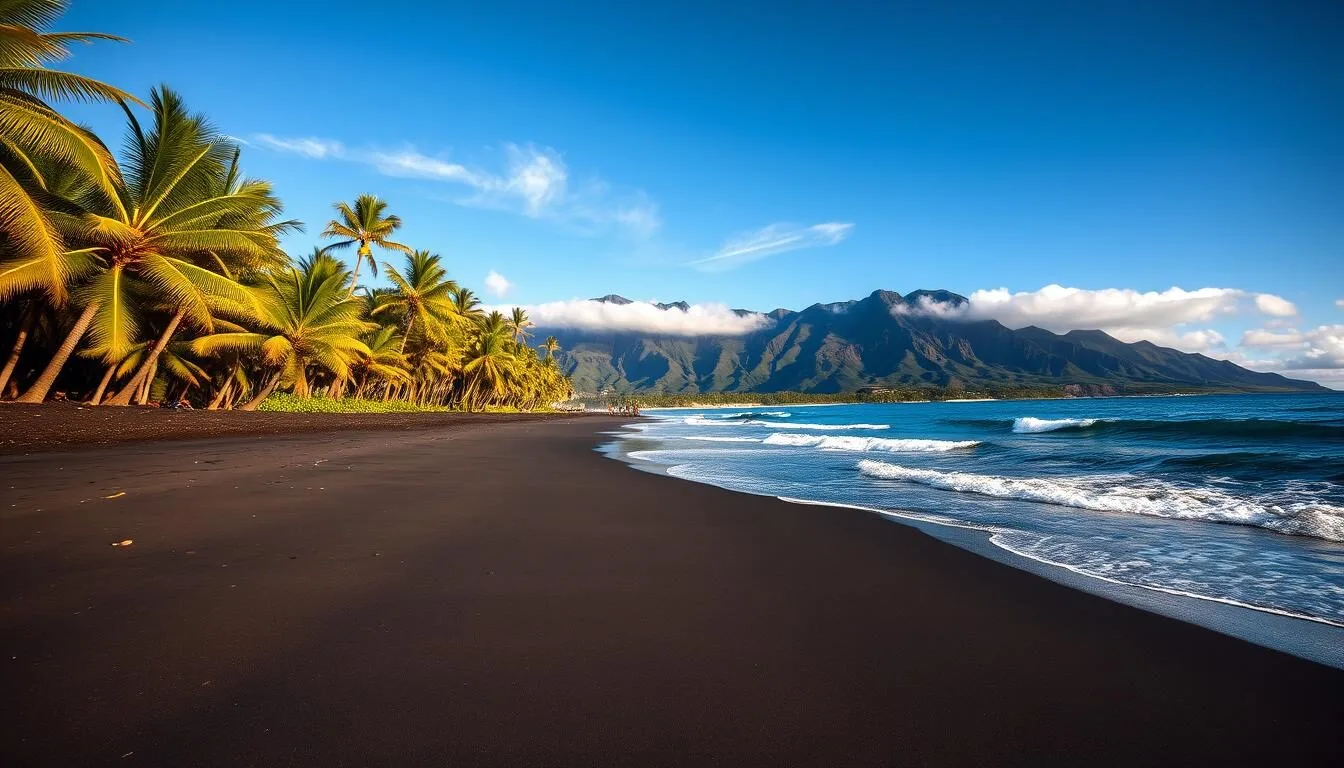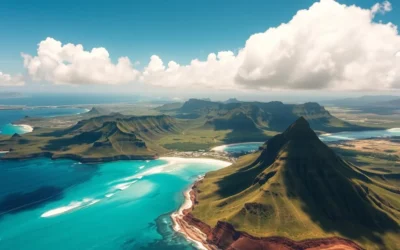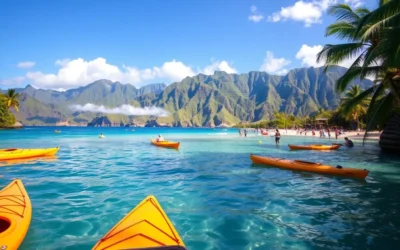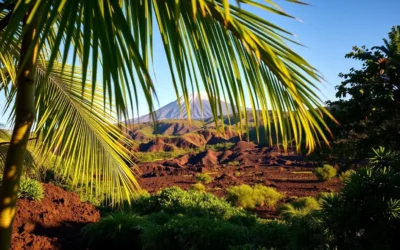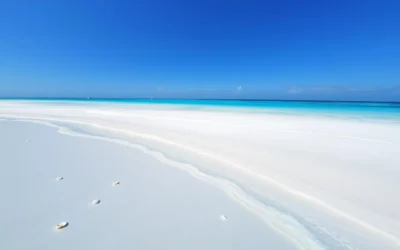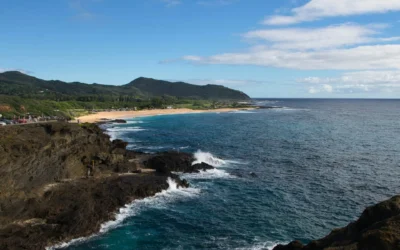✓ Accommodations ✓ Flights ✓ Rental Cars ✓ Tours & Activities
Imagine standing on a shoreline where the sand is as black as coal, a result of centuries of volcanic activity. You are now at Punaluʻu Black Sand Beach, one of the most renowned black sand beaches in the Hawaiian islands.
Located on the southeastern Kaʻu coast of the Big Island, this natural wonder is a must-visit destination for nature lovers and photographers. The beach is known for its striking jet-black shoreline and is home to endangered Hawaiian green sea turtles that often bask on the warm sand.
As you plan your visit, you’ll want to know about the activities available, from wildlife viewing to picnicking, and the cultural significance of the area. Our comprehensive guide will provide you with practical information about facilities, best times to visit, and nearby attractions to make your trip unforgettable.
Discovering Punaluʻu Black Sand Beach
As you step onto Punaluʻu’s black sands, you’re experiencing one of Hawaii’s most breathtaking natural attractions. This beach is not just a scenic spot; it’s a place steeped in history and natural wonder.
What Makes Punaluʻu Beach Special
Punaluʻu Beach is renowned for its unique black sand, created by volcanic lava flows. The beach is also a haven for green sea turtles, often seen basking in the sun on its shores. The presence of freshwater springs flowing into the ocean adds to its uniqueness, creating a special environment where fresh and saltwater meet.
The Meaning Behind the Name
The name “Punaluʻu” translates to “spring (water) diver for” in the Hawaiian language, reflecting the area’s unique hydrological features. Ancient Hawaiians would dive into the ocean with gourd vessels to collect fresh water from underwater springs during droughts, making Punaluʻu an important place for early Hawaiian communities.
| Feature | Description | Significance |
|---|---|---|
| Black Sand | Created by volcanic lava flows | Unique landscape feature |
| Freshwater Springs | Flow into the ocean | Creates a mix of fresh and saltwater |
| Green Sea Turtles | Bask on the beach | Protected species, cultural significance |
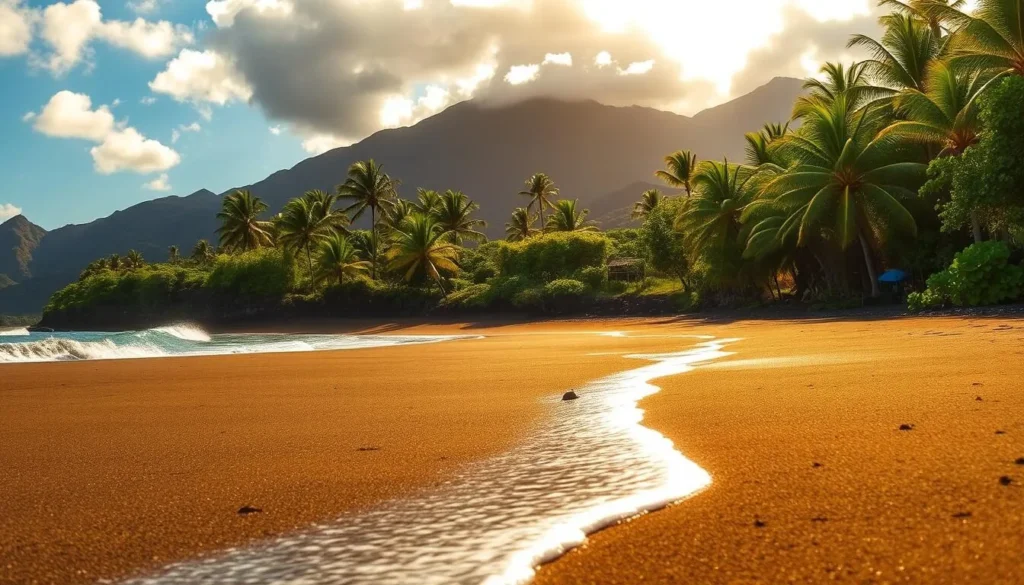
The Unique Black Sand of Punaluʻu
The black sand of Punaluʻu Beach is not only visually stunning but also steeped in geological and cultural significance. As you visit this remarkable place, understanding the origins and importance of its black sand can enhance your appreciation of this natural wonder.
How the Black Sand Formed
The black sand at Punaluʻu Beach is a result of volcanic activity. Lava flows into the ocean, cools, and shatters into fragments, which are then ground into fine sand by the constant pounding of waves. This process, occurring over centuries, has created the distinctive black black sand that characterizes the beach.

Why You Shouldn’t Take Sand Home
It’s tempting to take a souvenir of your visit, but removing sand or rocks from Punaluʻu Beach is not only against the law but also harmful to the ecosystem. The black sand is a finite resource that cannot be naturally replenished except through new volcanic activity. Moreover, Hawaiian legend warns that taking these natural materials angers Pele, the goddess of volcanoes, bringing bad luck to those who do so. By leaving the sand in its natural place, you help preserve the beauty of Punaluʻu Beach for future generations and respect local cultural beliefs.
Wildlife at Punaluʻu Beach
Punaluʻu Beach is renowned for its rich wildlife, including several endangered species. The beach’s unique ecosystem, with its mix of fresh and salt water, creates special conditions that support diverse marine life.
Green Sea Turtles (Honu)
The Green Sea Turtle, or honu, is a beloved and endangered species at Punaluʻu Beach. These turtles were nearly depleted in the 1960s and remain on the threatened species list. Visitors can often spot them basking on the black sand or swimming in the nearshore waters.
Other Endangered Species
Beyond Green Sea Turtles, Punaluʻu Beach is home to other endangered species, including the critically endangered Hawksbill turtle (honu’ea) and the Hawaiian monk seal. The Hawaiian hawk (ʻio) nests in the trees overlooking the shore. Snorkelers can enjoy the various fish species in the nearshore waters when conditions are calm. It’s essential to practice responsible wildlife viewing to protect these vulnerable species.
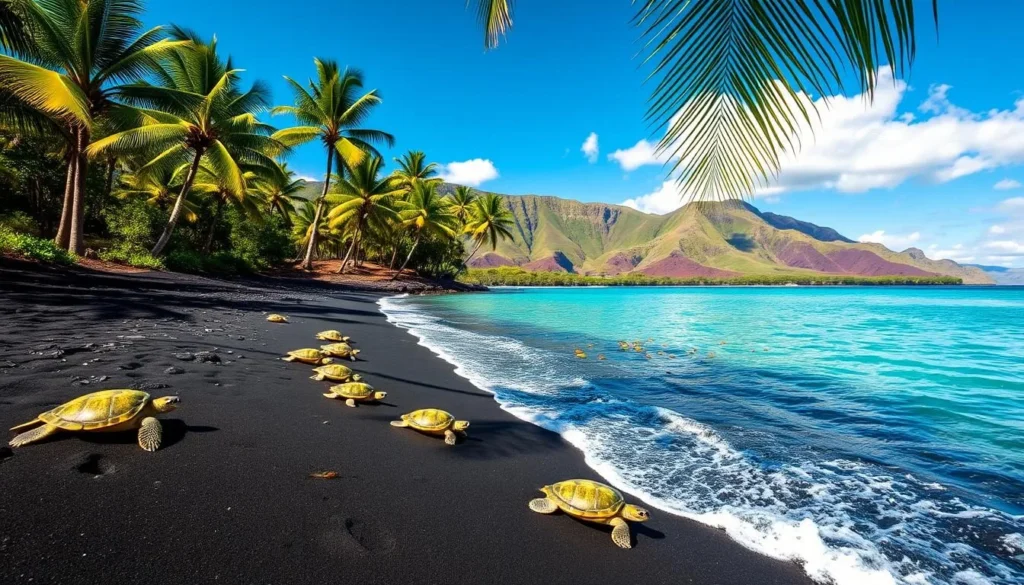
Getting to Punaluʻu Beach
Getting to Punaluʻu Beach is an adventure in itself, with scenic routes that showcase the Big Island’s diverse landscapes. Whether you’re driving from Hilo or Kona, the journey is filled with unique attractions and breathtaking views.
Driving Directions from Hilo
From Hilo, take Highway 11 south towards Punaluʻu Beach. This route takes you through various landscapes, showcasing the Big Island’s natural beauty. Be sure to stop at notable attractions along the way to enhance your trip.
Driving Directions from Kona
Driving from Kona, you’ll embark on an approximately 2-hour drive south on Highway 11, passing through the famous Kona coffee belt. Stop at coffee farms for tours and tastings of authentic 100% Kona coffee. Notable towns like Kealakekua and Captain Cook offer historical significance and great stopping points. The scenic drive along the Big Island’s coast is a treat, with dramatic climate changes from the dry Kona coast to the more lush southern areas.
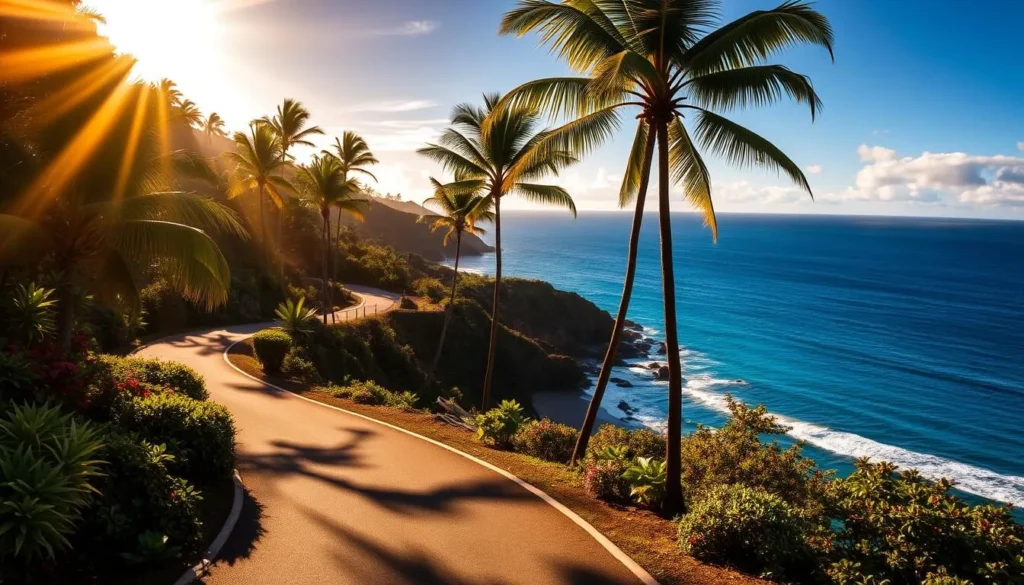
Best Times to Visit Punaluʻu Beach
Timing is everything when it comes to enjoying the natural beauty and wildlife of Punalu’u Beach. Understanding the best times to visit can significantly enhance your experience, especially if you’re hoping to see the iconic green sea turtles.
Seasonal Considerations
Punalu’u Beach is a year-round destination, but the experience can vary with the seasons. While the weather remains relatively consistent, the number of visitors and the presence of certain wildlife can change. It’s essential to be prepared for crowds during peak tourist seasons. Visiting during the shoulder season can offer a more serene experience.
| Season | Weather | Crowds |
|---|---|---|
| Peak Season | Sunny | Busy |
| Shoulder Season | Mild | Moderate |
| Off-Season | Variable | Less Crowded |
Daily Timing for Turtle Viewing
The green sea turtles at Punalu’u Beach are a major attraction, and the afternoon is typically the best time to observe them basking on the black sand. The turtles usually come ashore between 11 a.m. and 6 p.m., making mid-day to late afternoon the optimal viewing hours. Arriving early can help secure a good viewing spot, especially during busy periods. 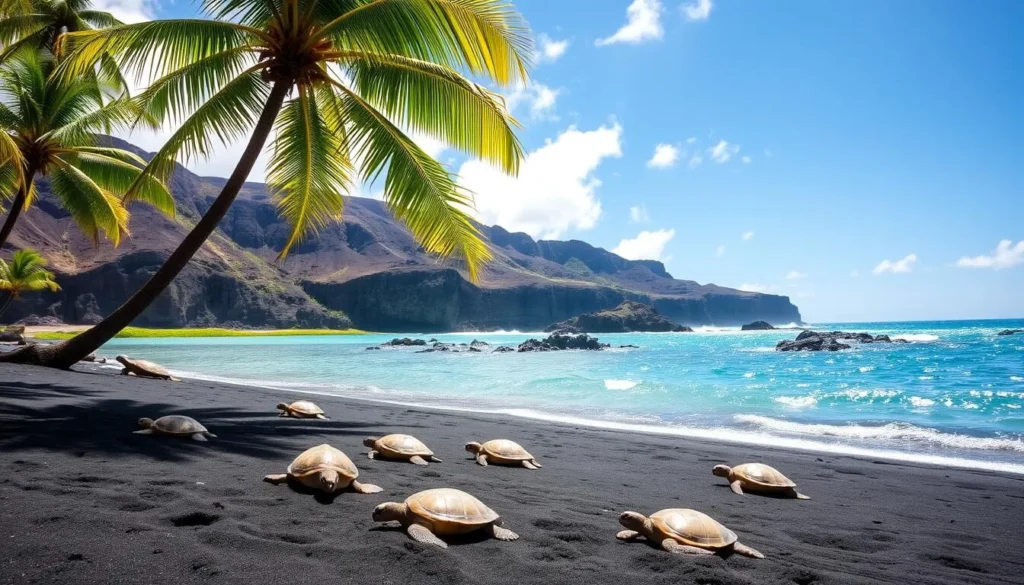
- Mid-day to late afternoon is best for turtle viewing.
- Turtles come ashore to warm up after morning feeding.
- Maintain a respectful distance of at least 10-15 feet.
Beach Facilities and Amenities
Punaluʻu Black Sand Beach offers a range of amenities to make your visit enjoyable and safe. The facilities are designed to cater to the needs of visitors, ensuring a comfortable experience.
Restrooms and Picnic Areas
The beach is equipped with restrooms and picnic areas, allowing you to relax and enjoy the surroundings. You can take a break and have a meal while appreciating the beautiful ocean views.
Lifeguard Services and Safety Information
Safety is a top priority at Punaluʻu Beach, with lifeguard services available daily from 8:30 a.m. to 5:00 p.m. Be aware of the strong rip current that runs out into the ocean, and check with lifeguards about current water conditions before swimming. When the surf is high or warning flags are posted, it’s recommended to avoid swimming and enjoy other beach activities instead. Always be mindful of the waves and ocean conditions to ensure your safety.
- Lifeguards on duty daily from 8:30 a.m. to 5:00 p.m.
- Be cautious of strong rip currents and changing ocean conditions.
- Avoid swimming during high surf or when warning flags are posted.
Activities at Punaluʻu Beach
Visitors to Punaluʻu Beach can enjoy a range of activities that showcase the beach’s natural beauty. The beach offers a unique combination of natural wonders and exciting experiences.
Swimming and Snorkeling
The clear waters of Punaluʻu Beach make it an ideal spot for swimming and snorkeling. You can explore the underwater world and observe marine life in its natural habitat. Snorkeling gear can be rented or purchased in nearby towns to enhance your experience.
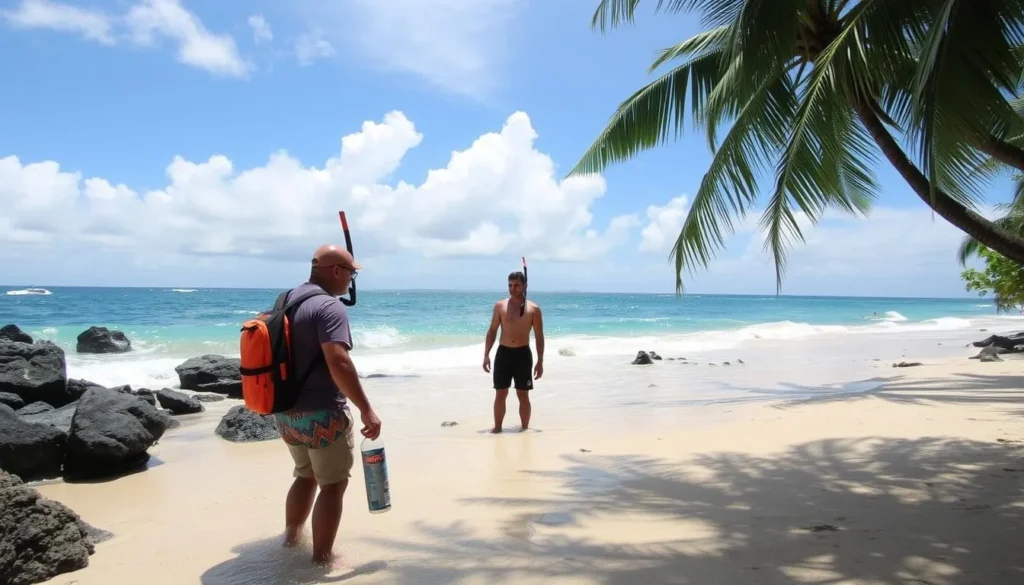
Walking and Photography
Take a leisurely walk along the beach and capture the stunning scenery with your camera. The unique black sand and dramatic landscapes make for breathtaking photographs. Be sure to keep an eye out for the native wildlife, including the green sea turtles.
Fishing Opportunities
Fishing is a popular activity at Punaluʻu Beach, particularly among locals. The waters are abundant with fish, making it a great spot for both beginners and experienced anglers. Nighttime fishing is especially productive, with many species more active after dark.
To make the most of your fishing experience, familiarize yourself with Hawaii’s fishing regulations, including size and catch limits. Fishing supplies can be purchased in nearby towns. Consider camping at the beach to try night fishing, but be sure to follow responsible fishing practices.
Camping at Punaluʻu Beach
For those who love the outdoors, camping at Punaluʻu Beach is an adventure worth considering. The beach offers a unique camping experience with its stunning black sand and tranquil atmosphere.
Permit Information
To camp at Punaluʻu Beach, you’ll need to obtain a permit. The permit system helps manage the number of campers and ensures that the area remains pristine. You can obtain more information about the permitting process through the relevant authorities.
Camping Facilities and Tips
The campground at Punaluʻu Beach is equipped with restrooms, outdoor showers, picnic tables, potable water, and communal grills, making your camping experience comfortable. However, be aware that the campground is an open area with little privacy between sites. To make the most of your camping experience, bring extra stakes for your tent due to potential coastal winds, and don’t forget adequate sun protection as shade is limited. Additionally, be mindful of the rules: no open fires, no pets, and no removal of natural materials like sand or rocks.
Historical and Cultural Significance
Punalu’u Beach is not only a natural wonder but also a site of great historical and cultural significance. As you explore this beautiful area, you’ll discover the rich heritage that makes it so special.
Ancient Hawaiian Connections
The Ka’u coast, where Punalu’u is located, has been home to Native Hawaiians for centuries. The island‘s history is deeply intertwined with the land and sea, with stories and legends passed down through generations. You can still feel the spiritual connection the ancient Hawaiians had with this sacred land.
Tsunami History and Impact
Punalu’u has faced numerous tsunamis throughout its history, with significant events occurring in 1868, 1960, and 1975. The 1868 tsunami brought waves as high as 100 feet, destroying shoreline communities. Despite these challenges, the local community rebuilt, demonstrating their resilience. A historical pier was built in the 1880s to transport sugar cane, showing how the area adapted over time. Understanding this history helps you appreciate the dynamic relationship between land and sea in Hawaii, coming to this way of life.
| Tsunami Year | Impact |
|---|---|
| 1868 | Waves as high as 100 feet, destroyed shoreline communities |
| 1960 | Further erosion and damage to the coastline |
| 1975 | Additional tsunami event, continued community resilience |
![]()
Nearby Attractions Worth Visiting
As you visit Punaluʻu Black Sand Beach, you’ll find several nearby attractions worth exploring on the Big Island. Your trip can be extended to include some of the region’s most fascinating spots.
One of the premier attractions is Hawaii Volcanoes National Park, located about 30 minutes from Punaluʻu Beach. Here, you can explore active volcanoes and dramatic landscapes, making it a must-visit national park on your itinerary.
- Visit the Punalu’u Bake Shop in nearby Na’alehu, famous for its delicious Hawaiian sweet bread and known as the “southernmost bakery in the USA”.
- Explore the Kona coffee belt, with numerous coffee farms offering tours and tastings of Hawaii’s famous coffee.
- Stop by Ka Lae (South Point), the southernmost point in the United States, offering dramatic cliff views.
- Discover Papakōlea Green Sand Beach, one of only four green sand beaches in the world, located near South Point.
- Visit the charming town of Pahala, which offers a glimpse into Hawaii’s plantation past and has several small shops and eateries worth visiting.
To fully appreciate Punaluʻu Beach and its surroundings, consider planning a full day or multi-day trip. The driving distance from Kailua-Kona is around 67 miles, taking approximately two and a half hours from Waikoloa, and about an hour’s drive south of Hilo, making it an ideal stop on your Big Island adventure, worth spending a few hours exploring.
Conclusion
As one of Hawaii’s most accessible black sand beaches, Punaluʻu offers an unforgettable experience. You can observe endangered Hawaiian green sea turtles in their natural habitat, making this beach not just beautiful but ecologically significant. The black sand formed by volcanic activity is a rare geological wonder. Visitors can enjoy various activities, including wildlife viewing, photography, and exploring cultural sites. With its convenient facilities and amenities, Punaluʻu Beach is suitable for visitors of all ages. Practice responsible tourism by respecting wildlife and leaving no trace to preserve this Big Island gem.
The above is subject to change.
Check back often to TRAVEL.COM for the latest travel tips and deals.
